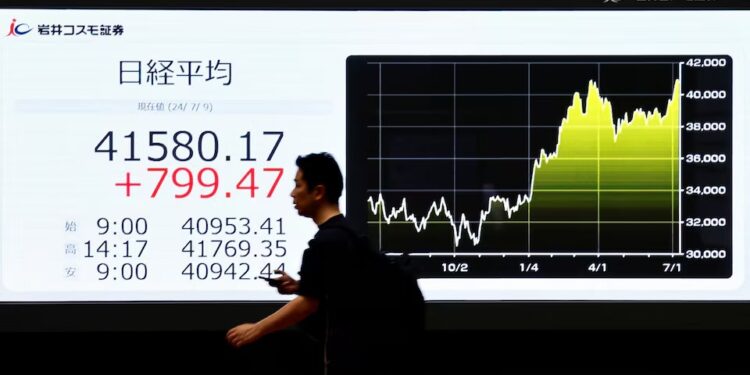Asian stocks hovered near two-year highs on Wednesday on growing bets of imminent U.S. rate cuts, while the New Zealand dollar slid after its central bank signalled greater confidence that inflation was coming to heel.
The Reserve Bank of New Zealand (RBNZ) held its cash rate steady at 5.5% on Wednesday as expected, but noted that inflation was expected to return to its target range of 1% to 3% in the second half of the year.
The Kiwi fell more than 0.7% in the aftermath of the decision and was last at 0.54% lower at $0.6092, as traders sharply ramped up bets of RBNZ rate cuts later this year.
“Them kind of saying the CPI is going to drop back into the target in the second half of this year… that CPI expectations could normalise more rapidly, I think that contributed,” said Alvin Tan, head of Asia FX strategy at RBC Capital Markets.
“Compared to the more hawkish statement, the tone they had in the May meeting, stood out.”
Swaps now imply more than 30 basis points worth of easing in October compared to 16 bps before the outcome.
The Aussie, meanwhile, rallied 0.6% to touch an over one-year high against the New Zealand dollar, with the former underpinned by wagers that the next move in Australian rates might be up given inflation is proving stubborn.
MSCI’s broadest index of Asia-Pacific shares outside Japan eased 0.16% but remained close to the more than two-year high hit at the start of the week.
Japan’s Nikkei rose 0.5%, while Hong Kong’s Hang Seng Index (.HSI), edged up 0.1%.
S&P 500 futures gained 0.05%, while Nasdaq futures firmed 0.14%. EUROSTOXX 50 futures tacked on 0.2%.
Stocks have rallied globally on the back of growing expectations of a Fed easing cycle likely to commence in September, with Powell saying on Tuesday that the U.S. is “no longer an overheated economy”.
However, he provided little clues on how soon those rate cuts could come.
“If the labour market shows signs of cooling, so long as inflation data doesn’t move higher and stays where it is, that might be enough to deliver some music from the Fed still,” said Rob Carnell, ING’s regional head of research for Asia Pacific.
The closely-watched U.S. inflation report is due on Thursday, with expectations for core consumer prices to have held steady every month in June.
DOLLAR RESILIENT
Markets are now pricing in an over 70% chance of a Fed cut in September, compared to a near-even chance a month ago, according to the CME FedWatch tool.
Still, the rise in U.S. rate cut expectations has done little to sway the dollar, which remained broadly on the front foot on Wednesday.
That left sterling and the euro little changed at $1.2791 and $1.0817, respectively. Against the yen, the dollar rose 0.15% to 161.54, as the Japanese currency continued to be pressured by stark interest rate differentials between the U.S. and Japan.
But data on Wednesday showed Japan’s wholesale inflation accelerated in June as the yen’s declines pushed up the cost of raw material imports, keeping alive market expectations for a near-term interest rate hike by the central bank.
The Bank of Japan said on Tuesday that some market players called on the central bank to slow its bond-buying to roughly half the current pace under a scheduled tapering plan due this month.
Elsewhere in Asia, data on Wednesday showed China’s consumer prices grew for a fifth month in June but missed expectations, while the producer price deflation persisted, as government support measures set a bumpy recovery in motion for the world’s second-largest economy.
The onshore yuan fell to its weakest level since November after the downbeat data and last stood at 7.2756 per dollar. Its offshore counterpart similarly fell 0.05% to 7.2919 per dollar.
In commodities, oil prices ticked lower. Brent futures fell 0.32% to $84.39 a barrel, while U.S. West Texas Intermediate (WTI) crude eased 0.25% to $81.21 per barrel.
Source: Reuters



Recent Comments